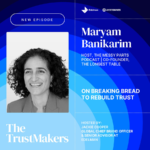By Anthony Yam, EVP, Product, Innovid
For years, identity was primarily discussed in the context of privacy and signal deprecation. It served as a workaround for cookie loss, mobile ID restrictions, and evolving regulatory expectations. As new rules emerged and third-party signals became less reliable, identity became a go-to strategy for maintaining addressability and effectiveness.
Today, identity is playing a larger and more central role. The latest Mediaocean H2 2025 Market Report shows that identity saw the biggest increase in strategic priority, rising 41 percent, while privacy saw the biggest decrease, falling 26 percent. These numbers suggest a shift away from reactive compliance strategies and point to a broader understanding of identity’s value across the marketing ecosystem.
Google’s ongoing delays to cookie deprecation in Chrome have also shifted the conversation. Marketers are placing less emphasis on emergency replacements and more on building durable infrastructure. Identity has become a foundation for coordination, measurement, and performance across platforms. Several trends help explain why.
Omnichannel Fragmentation
Modern marketing spans more channels, platforms, and devices than ever. Each environment has its own identifiers, metrics, and audience definitions. This fragmentation makes it difficult to understand how campaigns perform at the customer level or how exposures add up across channels.
Identity provides the thread that connects these fragmented points. A persistent identifier is the spine that allows marketers to unify planning, measurement, and optimization across fragmented sources of media and data. With a consistent view of the customer, it becomes possible to manage frequency, improve creative relevance, and measure outcomes more clearly. In a structurally disconnected ecosystem, identity helps create cohesion.
System-Level Coordination in CTV and Beyond
Identity is also becoming essential for how the broader advertising system operates. CTV is one of the clearest examples. Advertisers regularly buy CTV inventory across DSPs, publisher-direct channels, and linear TV extensions. Each source typically manages frequency in isolation, meaning the same viewer could be shown the same ad multiple times across different platforms without the buyer ever realizing it.
To manage frequency effectively, buyers need a consistent ID that can track exposure across all touchpoints in real time and suppress further delivery once frequency caps are met. Identity also supports better allocation of impressions, enabling buyers to reach underexposed or high-value audiences. This kind of coordination depends on identity systems that work across the full supply chain, not just within individual platforms.
Similar dynamics apply to measurement and optimization. When identity is used as a shared layer across systems, it helps align how media is bought, delivered, and evaluated.
Fueling AI-Driven Workflows
Identity is also playing a critical role in the growth of AI-driven marketing. As more teams adopt generative and analytical AI tools for planning, personalization, and content development, the need for structured, high-quality inputs is growing.
Identity-linked data helps improve the accuracy and relevance of AI outputs. It provides a consistent view of who the audience is, how they’ve engaged, and where they are in the journey. This allows AI models to generate better creative, make smarter decisions, and support dynamic optimization across campaigns.
Marketers are investing in identity not just to maintain signal coverage, but to unlock the full potential of systems that depend on audience-level insight.
Critical Infrastructure
Identity has evolved from a tactical solution into a core component of marketing infrastructure. It supports cross-channel coordination, enables real-time decision-making, and powers a growing set of tools and workflows across the organization.
The market is moving toward systems that are more integrated, more intelligent, and more dependent on clean, connected data. Identity is at the center of that movement—and it’s becoming harder to operate effectively without it.











